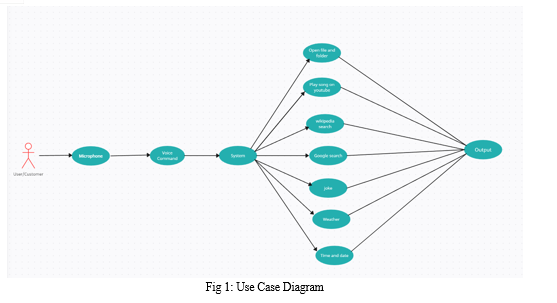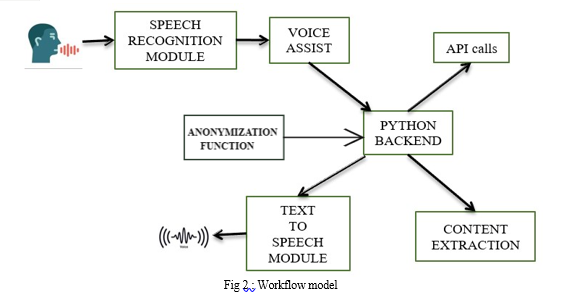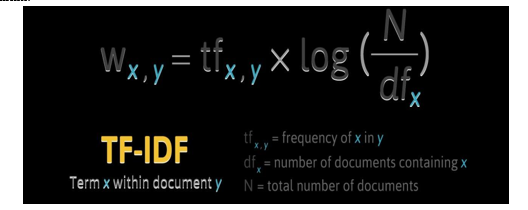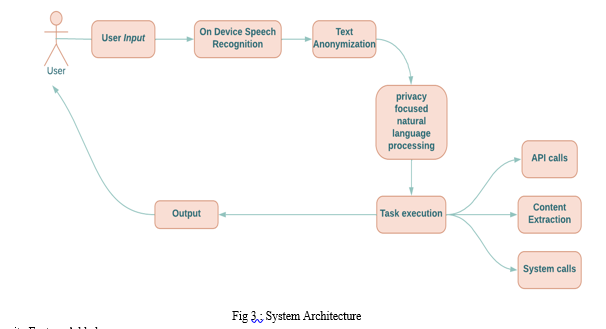Ijraset Journal For Research in Applied Science and Engineering Technology
- Home / Ijraset
- On This Page
- Abstract
- Introduction
- Conclusion
- References
- Copyright
AURA-The Privacy Preserving Multifunctional Desktop Voice Assistant
Authors: Aditi Dhumal, Vishal Yadav, Aniket Dhere, Navnath Bagal
DOI Link: https://doi.org/10.22214/ijraset.2024.62158
Certificate: View Certificate
Abstract
The “AURA” is the project which proposes the development of the versatile desktop voice assistant which mainly focuses on the privacy of the user.The convenience of voice interaction has surged in popularity, but concerns about user privacy remain. Conventional cloud-based voice assistants raise anxieties regarding data collection, storage, and potential misuse. This survey paper explores the burgeoning field of privacy-preserving desktop voice assistants powered by Artificial Intelligence (AI). We delve into the core challenges of on-device speech recognition, natural language understanding, and response generation while maintaining user privacy. We conclude by outlining open research questions and future directions for this evolving field, paving the way for the development of secure and user-centric voice interaction experiences on desktops.
Introduction
I. INTRODUCTION
The primary objective of the project is to develop the desktop voice assistant which can perform multiple tasks based on the commands given by the user while concerning the privacy of the user.In today's digital world, voice assistants have become increasingly popular, offering a convenient way to interact with technology through spoken commands. However, these assistants often raise privacy concerns as they require access to user audio data for speech recognition and potentially other functionalities. This is particularly true for desktop environments where users may handle sensitive information.
In today's digital world, voice assistants have become increasingly popular, offering a convenient hands-free way to interact with technology. However, these assistants often raise concerns about privacy, as they typically require constant access to user data and potentially transmit recordings to remote servers for processing. This raises the need for a new generation of voice assistants that prioritise user privacy while maintaining functionality.
This paper proposes the development of a privacy-preserving multifunctional desktop voice assistant. This novel system aims to address the growing demand for user privacy in voice interaction while offering a comprehensive suite of features for an enhanced desktop experience.
The following sections will explore the importance of privacy in voice assistants, the limitations of current systems, and the functionalities envisioned for this new privacy-focused desktop assistant. We will then delve into the proposed technical approach that ensures user privacy while enabling robust voice interaction functionalities.
This research aims to contribute to the field of human-computer interaction by providing a secure and user-centric voice assistant experience for desktop environments.
II. LITERATURE SURVEY
- This paper deals with the Speech Recognition Intelligence System for Desktop Voice Assistant by using AI &IoT, with statistical testing of hypothesis.In the modern era of reckless technology, we are able to carry out tasks that we never could have imagined testing we would be able to prepare for. However, in order to carry out these daydreams, we need a method that makes it simple for us to automate the things we do every day. As a result, we created applications like Voice Assistant that can communicate with us solely through human interaction . A voice assistant can be used by a number of applications, including AI and IoT. It has the ability to alter how users and machines communicate. By using voice commands, the user can access all of the features of this application, which has been designed machines to work with mobile phones.The primary difficulties and drawbacks of various voice assistants will be discussed in this paper. In this paper, we talk about how to make a voice based assistant that doesn't need cloud services, which would help these devices grow in the future.
- This paper addresses the primary goal of the trending technology AI is to realise natural human machine dialogue. Various IT-based companies also utilised dialogue networks technology to create various types of Virtual Personal Assistants focused on their products and areas for expanding human-machine contact, such as Alexa, Cortana, Google's Assistant, Siri and so more. Just like the Microsoft voice assistant named 'Cortana', we designed our virtual assistant which performs basic tasks based on the instruction provided to it on the Windows platform using Python. Here, Python is used as a scripting language as it has a large library that is used to perform instructions. Using Python packages, a personalised virtual assistant recognizes and processes the user's voice.
- This paper deals with a personal virtual assistant that allows a user to command or ask questions in the same manner that they would do with another human and are even capable of doing some basic tasks like opening apps, doing Wikipedia searches without opening a browser, playing music etc, with just a voice command.
- This paper addresses that the Personal Assistants, or conversational interfaces, or chat bots reinvent a new way for individuals to interact with computes. A Personal Virtual Assistant allows a user to simply ask questions in the same manner that they would address a human, and are even capable of doing some basic tasks like opening apps, reading out news, taking notes etc., with just a voice command. Personal Assistants like Google Assistant, Alexa, Siri works by Speech Recognition (Speech-to-text) and Text-to Speech. Keywords: Personal Assistants; chat bots; conversational interfaces; Speech Recognition; Text-to Speech.
- Artificial Intelligence has been fast emerging as a noteworthy technology that has the capability to revolutionise the cognitive behaviour of humans by simulating their intelligence for the betterment of mankind. AI consists of multi functional technologies which plays a significant role in our everyday lives like home automation where controlling the computer and performing multiple tasks using voice commands to remote monitoring and control activities. This study is aimed at designing an AI based virtual assistant that acts as a human language interface through automation and voice recognition based interaction from human based on Python . The instructions for the Voice Assistant are implemented as per the user requirement .The most successful Speech recognition software like Alexa, Siri, etc has been the brainchild of AI technology. Speech Recognition API in python converts speech into text thereby sending and receiving the emails without typing, searching the keywords in Google without opening the browser, and carrying out many other tasks like playing music etc., has been made possible through the help of this AI based virtual Assistant software.In the present scenario, innovation in digital technologies has resulted in increased effectiveness and accurateness of several tasks that would have required large amount of human effort and resources.. Multi-functional aspects like voice commands, sending emails, reading PDF, sending text on Whats-App, opening a command prompt or IDE, playing music, performing keyword searches in Wikipedia , giving weather forecast, desktop reminders of your choice etc are some of the major operations that can be performed by the developed AI based virtual assistant which also possess certain basic conversational abilities. ,pyttsx3, Speech Recognition, Date time, Wikipedia, Smtplib, pywhatkit, pyjokes, pyPDF2, pyautogui, pyQt etc are some of the tools utilized for the project. A live GUI has been designed for interacting with the AI virtual Assistant as it presents an elegant design framework to carry out the necessary conversation.
- The topic of this essay is the technologies are evolving rapidly day by day with the development of these technologies. Humans can perform their daily tasks easily. one of the most popular field of technology is artificial intelligence which is growing nowadays. Using artificial intelligence machines can recognize human behaviour and on the basis of that it can respond to humans. the desktop voice assistant is the best example of developing artificial intelligence technology. These desktop voice assistants help humans to perform various tasks on the desktop easily just by using their voice. The voice assistant uses speech recognition modules which is useful for recognizing and understanding human input voice and on the basis of user input command it gives the required input queries or performs the given task like opening and closing different applications, can search and send messages on whatsapp without using keyboard or mouse. In this paper artificial intelligence technology is used to create a desktop voice assistant which will be helpful for the visually impaired and the people with disabilities. This desktop voice assistant can also be useful for normal people as it saves time and provides efficiency in doing our day to day tasks.
III. PROPOSED WORK
Voice assistant is one of the biggest problem solvers for the users of the desktop .Solution of every problem which can be faced by the user can be found in the fraction of the seconds and only with the voice commands.
The voice assistant AURA performs multiple tasks on the voice command given by the user while concerning the privacy of the user. It is useful for the user to perform multiple tasks only just with the voice command and it is also useful for the impaired persons who are unable to perform the tasks visually so the AURA can help them to perform the tasks just by their voice commands.

The user can perform multiple tasks using the AURA and some of the tasks are listed as below :
- Opening the file or folder: Every time while opening the file or folder in our system we need to go to that particular location and then open that file or folder but by using the AURA the user can open any file or folder just by giving the name of that file or folder in the voice command.
- Playing the video on YouTube: While users have to play any YouTube video it is mandatory to go to YouTube search for a particular video and then play that video but using AURA the user can play the video by command “play” along with the name of the video . This makes daily life for the user very easy.
- Search on Wikipedia: Wikipedia is the widely used website by many of the users worldwide. It can be used by students , corporate workers , and many more . The AURA helps all the users to search on Wikipedia only by giving the voice command without opening the Wikipedia website.
- Telling some joke: Now let's be honest, everyone would have had at least one moment in their life where they were so tensed up or had an argument with their close people. So, these moments can be chilled up at least ten percent with some random joke and the user can get a moment of joy.
- Telling the temperature/weather of any location: Let's start this with a question, why is it important for us to know the weather of the day? or why is it important for us to monitor the weather every day? The answer is pretty simple: it forewarns the users asking about the weather, telling them that "it might rain today so carry an umbrella if you want or weather it is a sunny day.
- Searching for what the user asks: Today in the 20th century, we people often get doubts and we need to clear that doubt as soon as possible else that one doubt will be multiplied and at the end, we'd have n doubts and to clear the doubts searching the question in the internet will give us an answer and clear our doubts and asking that to the assistant will save a lot of time. Other than clearing the doubts, we need to search a lot of questions or topics in the internet to keep up with the trend and we can do this searching just by giving command to our assistant, asking it to search a specific topic/question.
- Telling the time and date: The user can easily see today's date and the current time only by giving the voice command.
- Play songs from music folder: AURA can play the songs which are stored on the folder in your PC just by giving the command and the songs will automatically get played.And the user can get the help with opening the folder without going to that particular folder location.
These are the important features of the voice assistant but other than this, we can do an ample of stuff with the assistant.
The user gives the voice input through microphone performs the STT (Speech to Text) and assistant understand and converts it into a text and understand that text and perform the task said by the user

IV. IMPLEMENTATION OF PROPOSED WORK
A. Technologies Used
- Python: We have used Python to build the assistant as it supports Object Oriented Programming through which a lot of built-in functions are made keeping it less complicated to build the assistant. The assistant's query can be modified to suit the user's needs. Speech Recognition is a process of converting the audio into text which can be further used by the assistant to find what the user is requesting the assistant to do. The usage of Python is such that it cannot be limited to only one activity. Its growing popularity has allowed it to enter into some of the most popular and complex processes like Artificial Intelligence, Machine Learning (ML), natural language processing, data science etc. Python has a lot of libraries for every need of this project.
- Pyttsx3: Pyttsx3 stands for Python Text to Speech. It is a cross-platform Python wrapper for text-to-speech synthesis. It is a Python package supporting common text-to-speech engines on Mac OS X, Windows, and Linux. It works for both Python2.x and 3. versions. Its main advantage is that it works offline.
- NLP and Voice Recognition: Natural language processing (NLP) techniques are used to process and understand the voice commands the desktop voice assistant receives. This may involve tasks such as speech recognition, language understanding, intent recognition, and context extraction, to accurately interpret the user's commands.
- TF/IDF: Term Frequency - Inverse Document Frequency (TF-IDF) is a widely used statistical method in natural language processing and information retrieval. It measures how important a term is within a document relative to a collection of documents.

5. Anonymization function: There are two types of the anonymization - Text and voice anonymization
This is the added security feature in this project . This feature identifies the particular pattern in the data and protects that particular type of data. ex: email , phone number , address , location , etc.
B. System Architecture
The overall system design consists of following phases:
- Data collection in the form of speech.
- Voice analysis and conversion to text.
- Text Anonymization
- Execute Python script.
- API calls , System calls
- Generating speech from the processed text output.
In the first phase, the data is collected in the form of speech and stored as an input for the next phase for processing. In the second phase, the input voice is continuously processed and converted to text using STT. In the next phase the converted text is analysed and processed using Python Script to identify the response to be taken against the command. Finally once the response is identified, output is generated from simple text to speech conversion using TTS.

Security Feature Added :
Text Anonymization :
Text anonymization is the process of modifying text data to prevent the identification of individuals or sensitive information. It's crucial for protecting privacy in various situations, such as sharing medical records for research or publishing survey results. Here's a breakdown of key concepts and techniques:
Why Text Anonymization?
-Privacy Protection: Anonymization safeguards individuals' identities by redacting or modifying personal details like names, addresses, phone numbers, and even certain demographics.
-Data Sharing: Enables secure sharing of sensitive data for research, analysis, or public reporting while upholding privacy regulations like GDPR and HIPAA.
-Mitigates Risks: Reduces the risk of data breaches or unauthorised access that could expose personally identifiable information (PII).
Text Anonymization Techniques:
-Redaction: Simply removes or replaces sensitive text with symbols (****) or generic terms (e.g., "patient ID").
-Pseudonymization: Replaces PII with fictitious but consistent identifiers throughout the text. This allows some analysis while protecting identities (e.g., "John Doe" becomes "Participant A").
-Tokenization: Replaces sensitive words or phrases with random tokens that don't hold inherent meaning. This can be useful for anonymizing specific terminology within a broader text corpus.
V. RESULTS
The project work of the AURA voice assistant has been clearly explained in this report, how useful it is and how we can rely on a voice assistant for performing any task which the user needs to complete .It can perform the task which are useful for the user and many users can use it easily without any difficulty and perform the tasks with just voice command.
In this project we also created the GUI which helps the user to easily access the AURA . Users can use the AURA by activating it and they can deactivate whenever they want. All the commands and output to that commands are visible on the GUI created.
Development of the software is almost completed from our side and it's working fine as expected which was discussed for some extra development so, maybe some advancement might come in the near future where the assistant which we developed will be even more useful than it is now.

VI. FUTURE SCOPE
- Integration with Smart Devices: extending compatibility to interact with a broader range of smart devices,creating a more connected and streamlined user experience.
- Enhanced Privacy Features: continuous development and improvement of privacy mechanisms to stay ahead of emerging threats.
- Advanced AI Capabilities: incorporating cutting-edge AI technologies to improve natural language understanding, context awareness, and personalised user interactions.
- Ecosystem Expansion: integrating with a wider range of applications and services, making voice assistants an integral part of users' daily tasks and activities.
- Research and Innovation: staying at the forefront of AI research to integrate emerging technologies and maintain a competitive edge in providing state-of-art voice assistants.
Conclusion
Through this AURA voice assistant, we have automated various services using a single line command. It eases most of the tasks of the user like searching the web,retrieving weather forecast details, vocabulary help and medical related queries.We aim to make this project a complete server assistant and make it smart enough to act as a replacement for a general server administration. The AURA mainly focus on providing the services while concerning th users privacy .The future plans include integrating Jarvis with mobile using React Native to provide a synchronised experience between the two connected devices.The privacy-preserving multifunctional desktop voice assistant is a significant step forward in the development of voice interaction technologies that prioritise user privacy and security.
References
[1] Deller John R., Jr., Hansen John J.L., Proakis John G. ,Discrete-Time Processing of Speech Signals, IEEE Press, ISBN 0-7803-5386-2. [2] Hayes H. Monson,Statistical Digital Signal Processing and Modeling, John Wiley & Sons Inc. , Toronto, 1996, ISBN 0-471-59431-8. [3] Proakis John G., Manolakis Dimitris G.,Digital Signal Processing, principles, algorithms, and applications, Third Edition, Prentice Hall , New Jersey, 1996, ISBN 0-13- 394338-9. [4] Ashish Jain,Hohn Harris,Speaker identification using MFCC and HMM based techniques,university Of Florida,April 25,2004. [5] Rabiner Lawrence, Juang Bing-Hwang. Fundamentals of Speech Recognition Prentice Hall , New Jersey, 1993, ISBN 0-13-015157-2.
Copyright
Copyright © 2024 Aditi Dhumal, Vishal Yadav, Aniket Dhere, Navnath Bagal. This is an open access article distributed under the Creative Commons Attribution License, which permits unrestricted use, distribution, and reproduction in any medium, provided the original work is properly cited.

Download Paper
Paper Id : IJRASET62158
Publish Date : 2024-05-15
ISSN : 2321-9653
Publisher Name : IJRASET
DOI Link : Click Here
 Submit Paper Online
Submit Paper Online

